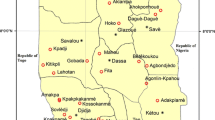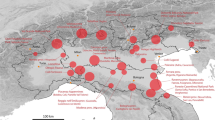Abstract
Enhancing orphan crops productivity in developing countries is of paramount importance to providing quality diets to the growing population as well as resilience options to smallholder farmers in order to adapt to climate change. However, the status of genetic resources diversity and the utilisation patterns of many orphan crops have been poorly investigated to inform breeding programs and management strategies. In this study, we assembled Kersting’s groundnut diversity, associated farmers’ knowledge and production systems across three ecological zones in Benin and Togo. We collected data through focus group discussions in 43 villages. In addition, semi-structured interviews were conducted with 300 farmers. Four cell analyses was performed using cropping areas and number of Kersting’s groundnut farmers as criteria. We conducted a comparative analysis of the Kersting’s groundnut utilisations and production systems across ecological zones. In total, 308 accessions of Kersting’s groundnut were collected using farmers’ criteria such as grain colour, grain size, maturity time, yield potential, medicinal properties and marketability. Farmers grouped the accessions into five landraces based solely on grain colour. All landraces were cultivated in the Sudanian zone while only three of them were found in the Guinean and Sudano-Guinean zones. Most of these landraces were produced by a few farmers on small cropping areas. The choice of landraces for production depended on local intention for production and different use categories across ecological zones. Up to 46.80% of decrease in cropping areas was observed in most zones due to specific production bottlenecks such as drought and diseases. We discuss our findings and suggest tailored actions including effective in situ and ex situ conservation strategies, germplasm collection and characterization in other countries where the crop is produced, development of new cultivars with farmers’ preferred traits and enhancement of the genetic base of the species.







Similar content being viewed by others
References
Abeyasekera S (2005) Quantitative analysis approaches to qualitative data: why, when and how? In: Holland JD, Campbell J (eds) Methods in development research; combining qualitative and quantitative approaches. ITDG Publishing, Warwickshire, pp 97–106
Achigan Dako EG, Vodouhè SR (2006) Macrotyloma geocarpum (Harms) Maréchal & Baudet. In: Brink M, Belay G (eds) Plant resources of tropical Africa 1. Cereals and pulses. Backhuys Publishers CTA, PROTA, Wageningen, pp 111–114
Adomou A (2005) Vegetation patterns and environmental gradients in Benin. Implications for biogeography and conservation. Wageningen University, Wageningen
Adu-Gyamfi R, Fearon J, Bayorbor T, Dzomeku I, Avornyo V (2011) The status of Kersting’s groundnut (Macrotyloma geocarpum [Harms] Marechal and Baudet): an underexploited legume in Northern Ghana. Outlook Agr 40:259–262
Ajayi OB, Oyetayo F (2009) Potentials of Kerstingiella geocarpa as a health food. J Med Food 12:184–187. https://doi.org/10.1089/jmf.2008.0100
Akoègninou A, Van der Burg W, Van der Maesen LJG (2006) Flore analytique du Bénin, vol 06.2. Backhuys Publishers, Wageningen
Aremu M, Osinfade B, Basu S, Ablaku B (2011) Development and nutritional quality evaluation of Kersting’s groundnut-ogi for African weaning diet. Am J Food Technol 6:1021–1033
Assogba P, Ewedje E-EBK, Dansi A, Loko YL, Adjatin A, Dansi M, Sann A (2016) Indigenous knowledge and agro-morphological evaluation of the minor crop Kersting’s groundnut (Macrotyloma geocarpum (Harms) Maréchal et Baudet) cultivars of Benin. Genet Resour Crop Evol 635:513–529. https://doi.org/10.1007/s10722-015-0268-9
Aworh OC (2015) Promoting food security and enhancing Nigeria’s small farmers’ income through value-added processing of lesser-known and under-utilized indigenous fruits and vegetables. Food Res Int 76:986–991
Ayenan MAT, Ezin VA (2016) Potential of Kersting’s groundnut [Macrotyloma geocarpum (Harms) Maréchal & Baudet] and prospects for its promotion. Agric Food Secur 5:1
Badii BK, Adarkwah C, Obeng-Ofori D, Ulrichs C (2014) Efficacy of diatomaceous earth formulations against Callosobruchus maculatus (F.) (Coleoptera: Bruchidae) in Kersting’s groundnut (Macrotyloma geocarpum Harms): influence of dosage rate and relative humidity. J Pest Sci 87:285–294
Baldermann S et al (2016) Are neglected plants the food for the future? Crit Rev Plant Sci 35:106–119
Cullis C, Kunert KJ (2017) Unlocking the potential of orphan legumes. J Exp Bot 68:1895–1903
Curran J (2012) The nutritional value and health benefits of pulses in relation to obesity, diabetes, heart disease and cancer. Br J Nutr 108:S1
Dalrymple DG (1986) Development and spread of high-yielding rice varieties in developing countries. International Rice Research Institute, Washington
Dansi A et al (2012) Diversity of the neglected and underutilized crop species of importance in Benin. Sci World J 2012:932947
Daryanto S, Wang L, Jacinthe P-A (2016) Global synthesis of drought effects on cereal, legume, tuber and root crops production: a review. Agric Water Manag 179:16
Di Falco S, Chavas J-P (2006) Crop genetic diversity, farm productivity and the management of environmental risk in rainfed agriculture. Eur Rev Agric Econ 33:289–314
Ebert AW (2014) Potential of underutilized traditional vegetables and legume crops to contribute to food and nutritional security, income and more sustainable production systems. Sustainability 6:319–335
FAO (2017) Regional overview of food security and nutrition in Africa 2017. The food security and nutrition–conflict nexus: building resilience for food security, nutrition and peace. FAO, Accra
Fousseni F, Madjouma K, Dieudonné GY, Li PD, Hai ZX, Koffi A (2014) Global overview of flora and plant diversity in Togo (West Africa). J life Sci Res 1:24–30
Harlan JR (1971) Agricultural origins: centers and noncenters. Science 174:468–474
Hoffman B, Gallaher T (2007) Importance indices in ethnobotany. ERA 5:201–218
Hummer KE, Hancock JF (2015) Vavilovian centers of plant diversity: implications and impacts. HortScience 50:780–783
INSAE (2015) RGPH4: Que retenir des effectifs de population en 2013 ?. Institut National de la Statistique et de l’Analyse Economique, Cotonou
Iwanaga M (1996) IPGRI strategy for in situ conservation of agricultural biodiversity. In: DSE/ATSAF/IPGRI workshop in situ conservation and sustainable use of plant genetic resources for food and agriculture in developing countries, Bonn (Germany), 2–4 May 1995. IPGRI
Jambo N (2017) The impact of government spending on agricultural growth: a case of Zambia, Malawi, South Africa and Tanzania. Stellenbosch University, Stellenbosch
Khasbagan, Soyolt (2008) Indigenous knowledge for plant species diversity: a case study of wild plants’ folk names used by the Mongolians in Ejina desert area, Inner Mongolia, P. R. China. J Ethnobiol Ethnomed 4:2. https://doi.org/10.1186/1746-4269-4-2
Kouris-Blazos A, Belski R (2016) Health benefits of legumes and pulses with a focus on Australian sweet lupins. Asia Pac J Clin Nutr 25:1–17
Last L et al (2014) Indicators for the on-farm assessment of crop cultivar and livestock breed diversity: a survey-based participatory approach. Biodivers Conserv 23:3051–3071
Mayes S, Massawe F, Alderson P, Roberts J, Azam-Ali S, Hermann M (2011) The potential for underutilized crops to improve security of food production. J Exp Bot 63:1075–1079
Mohammed M, Sowley E, Dakora F (2015) Symbiotic N2 fixation, C assimilation and water-use efficiency (WUE) of five Rhizobium-inoculated Kersting’s groundnut (Macrotyloma geocarpum) landraces measured using 15N and 13C isotopic techniques. S Afr J Bot 98:192
Mohammed M, Sowley E, Dakora F (2016) Variations in N2 fixation of field-grown Kersting’s groundnut (Macrotyloma geocarpum) landraces in response to inoculation with two Bradyrhizobium strains in the northern region of Ghana. S Afr J Bot 103:333
MPDAT (2011) Recensement général de la population et de l’habitat (06 au 21 Novembre 2010). Résultats définitifs. Lomé
Padulosi S, Thompson J, Rudebjer P (2013) Fighting poverty, hunger and malnutrition with neglected and underutilized species: needs, challenges and the way forward. Bioversity International, Rome
Pasquet R, Mergeai G, Baudoin J-P (2002) Genetic diversity of the African geocarpic legume Kersting’s groundnut, Macrotyloma geocarpum (Tribe Phaseoleae: Fabaceae). Biochem Syst Ecol 30:943–952
R Core Team (2017) R: a language and environment for statistical computing. R Foundation for Statistical Computing, Vienna. http://www.R-project.org/. Accessed 27 Jan 2018
Rana RB, Sthapit BR, Garforth C, Subedi A, Jarvis DI (2005) Four-cell analysis as a decision-making tool for conservation of agrobiodiversity on-farm. In: Sthapit BR, Upadhyay MP, Shrestha PK, Jarvis DI (eds) On-farm conservation of agricultural biodiversity in Nepal, vol 2. IPGRI, Rome, pp 15–24
Rao VR, Hodgkin T (2002) Genetic diversity and conservation and utilization of plant genetic resources. Plant Cell Tissue Organ Cult 68:1–19
Schroeder C, Onyango TKO, Nar RB, Jick N, Parzies H, Gemenet D (2013) Potentials of hybrid maize varieties for small-holder farmers in Kenya: a review based on Swot analysis. Afr J Food Agric Nutr, Dev, p 13
Sthapit B et al (2006) Participatory four cell analysis (FCA) for local crop diversity. In: Sthapit B, Shrestha P, Upadhyay M (eds) On-farm management of agricultural biodiversity in Nepal: Good practices, vol 260. LI-BIRD, Nepal, pp 13–16
Tadele Z (2017) Raising crop productivity in Africa through intensification. Agronomy 7:22
Ugulu I (2012) Fidelity Level and knowledge of medicinal plants used to make therapeutic Turkish baths. Stud Ethno Med 6:1–9. https://doi.org/10.1080/09735070.2012.11886413
Van Dusen E (2005) Understanding the factors driving on farm crop genetic diversity: empirical evidence from Mexico. In: Cooper J, Lipper LM, Zilberman D (eds) Agricultural biodiversity and biotechnology in economic development. Springer, Boston, pp 127–145
Van Dusen ME, Taylor JE (2005) Missing markets and crop diversity: evidence from Mexico. Environ Dev Econ 10:513–531
Vavilov NI, Dorofeev VF (1992) Origin and geography of cultivated plants. Cambridge University Press, New York
Whaanga H, Papa W, Wehi P, Roa T (2013) The use of the Māori language in species nomenclature. J Mar Isl Cult 2:78–84. https://doi.org/10.1016/j.imic.2013.11.007
Wickham H (2016) ggplot2: elegant graphics for data analysis. Springer, Houston
Zhukovsky P (1975) World gene pool of plants for breeding: mega-gene-centres and endemic micro-gene-centres. USSR Academy of Sciences, Leningrad
Acknowledgements
This work was financially supported by New Alliance Trust. We are thankful to all Kersting’s groundnut farmers in Benin and northern Togo for their availability and willingness to share their knowledge. We are also grateful to local authorities for facilitating germplasm collection in their respective villages.
Author information
Authors and Affiliations
Corresponding author
Ethics declarations
Conflict of interest
The authors declared that they have no conflict of interest.
Electronic supplementary material
Below is the link to the electronic supplementary material.
Rights and permissions
About this article
Cite this article
Akohoué, F., Sibiya, J. & Achigan-Dako, E.G. On-farm practices, mapping, and uses of genetic resources of Kersting’s groundnut [Macrotyloma geocarpum (Harms) Maréchal et Baudet] across ecological zones in Benin and Togo. Genet Resour Crop Evol 66, 195–214 (2019). https://doi.org/10.1007/s10722-018-0705-7
Received:
Accepted:
Published:
Issue Date:
DOI: https://doi.org/10.1007/s10722-018-0705-7




